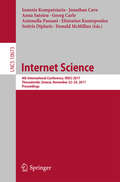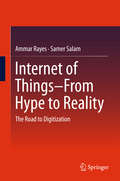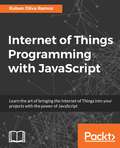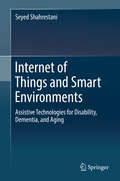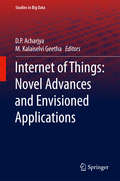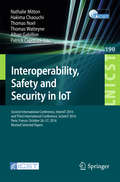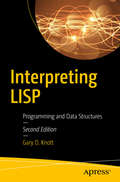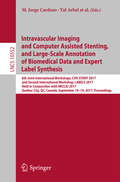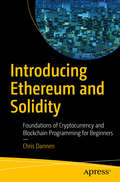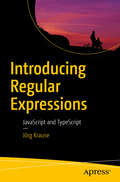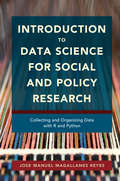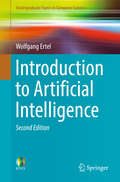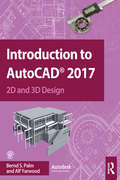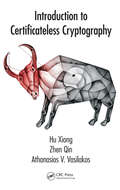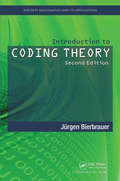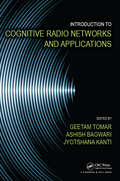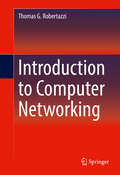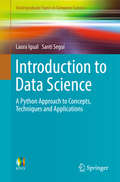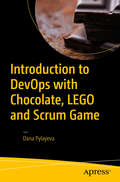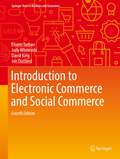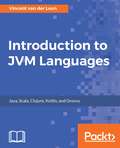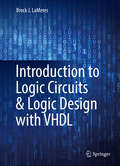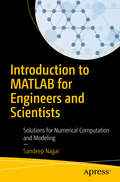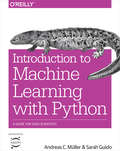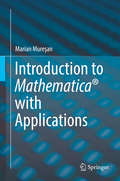- Table View
- List View
Internet Science: 4th International Conference, INSCI 2017, Thessaloniki, Greece, November 22-24, 2017, Proceedings (Lecture Notes in Computer Science #10673)
by Ioannis Kompatsiaris, Jonathan Cave, Anna Satsiou, Georg Carle, Antonella Passani, Efstratios Kontopoulos, Sotiris Diplaris and Donald McMillanThis book constitutes the proceedings of the 4th International Conference on Internet Science held in Thessaloniki, Greece, in November 2017. The 34 papers presented were carefully reviewed and selected for inclusion in this volume. They were organized in topical sections named: next generation community engagement; online policy, politics and co-creation; understanding and empowering digital citizens; data-driven research and design; social media and online interaction.
Internet of Things From Hype to Reality
by Ammar Rayes Salam SamerThis book comprehensively describes an end-to-end Internet of Things (IoT) architecture that is comprised of devices, network, compute, storage, platform, applications along with management and security components. It is organized into five main parts, comprising of a total of 11 chapters. Part I presents a generic IoT reference model to establish a common vocabulary for IoT solutions. This includes a detailed description of the Internet protocol layers and the Things (sensors and actuators) as well as the key business drivers to realize the IoT vision. Part II focuses on the IoT requirements that impact networking protocols and provides a layer-by-layer walkthrough of the protocol stack with emphasis on industry progress and key gaps. Part III introduces the concept of Fog computing and describes the drivers for the technology, its constituent elements, and how it relates and differs from Cloud computing. Part IV discusses the IoT services platform, the cornerstone of the solution followed by the Security functions and requirements. Finally, Part V provides a treatment of the topic of connected ecosystems in IoT along with practical applications. It then surveys the latest IoT standards and discusses the pivotal role of open source in IoT. "Faculty will find well-crafted questions and answers at the end of each chapter, suitable for review and in classroom discussion topics. In addition, the material in the book can be used by engineers and technical leaders looking to gain a deep technical understanding of IoT, as well as by managers and business leaders looking to gain a competitive edge and understand innovation opportunities for the future. " Dr. Jim Spohrer, IBM "This text provides a very compelling study of the IoT space and achieves a very good balance between engineering/technology focus and business context. As such, it is highly-recommended for anyone interested in this rapidly-expanding field and will have broad appeal to a wide cross-section of readers, i. e. , including engineering professionals, business analysts, university students, and professors. " Professor Nasir Ghani, University of South Florida
Internet of Things Programming with JavaScript
by Ruben Oliva RamosLearn the art of bringing the Internet of Things into your projects with the power of JavaScript About This Book • This is a practical guide to help you configure and build a complete distributed IoT system from scratch using JavaScript • Utilize the power of Node and HTML5 to develop web services and a centralized web server, enabling high-level communication between connected devices • Control all your connected devices from the browser by setting up a common dashboard Who This Book Is For This book is for developers who are interested in learning how to communicate with connected devices in JavaScript to set up an IoT system. Some basic knowledge of JavaScript is expected. Hobbyists who want to explore the potential of IoT in JavaScript will also find this book useful. What You Will Learn • Develop the skills to connected devices prepared the field to interact with the devices in a network system Internet of Things • Find out how to connect sensors and actuators to the devices • Send data to a web server connected devices • Understand Internet of things using web services and database • Configure a dashboard using HTML5 and JavaScript • Control devices connected from a dashboard • Monitor different devices from the dashboard • Build an app for a smartphone to control different devices In Detail The Internet of Things (IoT) is an entirely new platform for developers and engineers, but one thing that remains consistent as we move into this new world, are the programming languages. JavaScript is the most widely used language over the Internet, and with IoT gaining momentum, you will learn how to harness the power of JavaScript to interact with connected devices. This book will teach you how to interact with endpoint devices by developing web services in JavaScript and also set up an interface to control all connected devices. This book begins with setting up a centralized web server that serves as a hub for all connected devices. The book then progresses further towards building web services to facilitate high-level communication between connected devices. Using Arduino and Raspberry Pi Zero as endpoint devices, the book will show you how devices can communicate with each other, perform a wide range of tasks, and also be controlled from a centralized location using JavaScript. The book ends with creating a hybrid app to control the devices that can be run from a browser or installed on a smartphone. Style and approach This book offers step-by-step guidance on how to set up a distributed IoT system using JavaScript. It will teach you how to interact with endpoint devices by developing web services in JavaScript and also set up an interface for controlling all connected devices.
Internet of Things and Smart Environments
by Seyed ShahrestaniThis book is focused on the Internet of Things (IoT) services and smart environments that can be of assistance to the elderly and individuals living with dementia or some sensory impairment. The book outlines the requirements of the systems that aim to furnish some digital sensory or cognitive assistance to the individuals and their caregivers. Internet of Things and Smart Environments: Assistive Technologies for Disability, Dementia, and Aging covers the important evolutions of the IoT, the sensors, actuators, wireless communication and pervasive computing systems, and other enabling technologies that power up this megatrend infrastructure. The use of the IoT-based systems in improving the conventional assistive technologies and provisions of ambient assisted living are also covered. The book takes an impartial, and yet holistic, view to providing research insights and inspirations for more development works in the areas related to assistive IoT. It will show the potentials of using normally available interactive devices, like smartphones or smart TVs, which can be supplemented with low-cost gadgets or apps to provide assistive capabilities. It aims to accentuate the need for taking a comprehensive and combinatory view of the comprising topics and approaches that are based on the visions and ideas from all stakeholders. The book will examine these points and considerations to conclude with recommendations for future development works and research directions. This book can be of value to a diverse array of audience. The researchers and developers in healthcare and medicine, aged care and disability services, as well as those working in the IoT-related fields, may find many parts of this book useful and stimulating. It can be of great value to postgraduate and research students working in these areas. It can also be adapted for use in upper-level classroom courses relevant to communication and smart technologies, IoT applications, and assistive technologies. Many parts of the book can be of interest to the elderly and individuals living with a disability, as well as their families and caregivers. From an industry perspective, it can be of interest to software, hardware, and particularly app developers working on the IoT applications, smart homes and environments, and assistive technologies for the elderly and people living with disability or dementia.
Internet of Things: Novel Advances and Envisioned Applications
by D. P. Acharjya M. Kalaiselvi GeethaThis book focuses on a combination of theoretical advances in the Internet of Things, cloud computing and its real-life applications to serve society. The book discusses technological innovations, authentication, mobility support and security, group rekeying schemes and a range of concrete applications. The Internet has restructured not only global interrelations, but also an unbelievable number of personal characteristics. Machines are increasingly able to control innumerable autonomous gadgets via the Internet, creating the Internet of Things, which facilitates intelligent communication between humans and things, and among things. The Internet of Things is an active area of current research, and technological advances have been supported by real-life applications to establish their soundness. The material in this book includes concepts, figures, graphs, and tables to guide researchers through the Internet of Things and its applications for society.
Interoperability, Safety and Security in IoT
by Hakima Chaouchi Alban Gabillon Nathalie Mitton Thomas Noel Thomas Watteyne Patrick CapolsiniThis book constitutes the refereed post-conference proceedings of the International Conference on Safety and Security in Internet of Things , SaSeIoT 2016, which was collocated with InterIoT and took place in Paris, France, in October 2016. The 14 revised full papers were carefully reviewed and selected from 22 submissions and cover all aspects of the latest research findings in the area of Internet of Things (IoT).
Interpreting LISP
by Gary D. KnottLearn Lisp programming in a data structures context, including tables, functions, forms, expressions, typed-pointers, I/O, garbage collection and some applications. This short primer contains a careful description of the data structures manipulated by Lisp functions. These data structures and others, notably hash tables, are also used in constructing a Lisp interpreter. Interpreting Lisp will be of special interest to those learning and using programming languages and computer architecture as well as data structures. This book will be useful to autodidacts, professional programmers, and computer enthusiasts in a wide variety of fields. What You'll Learn Use the atom table and the number table in Lisp Master expressions, typed pointers, arguments and results in typed pointers, and more Write lambda expressions in Lisp Bind actual values to formal arguments Develop games in Lisp Who This Book Is For Experienced programmers new to Lisp.
Intravascular Imaging and Computer Assisted Stenting, and Large-Scale Annotation of Biomedical Data and Expert Label Synthesis
by Eric Granger Su-Lin Lee M. Jorge Cardoso Gustavo Carneiro Diana Mateus Tal Arbel Lena Maier-Hein Veronika Cheplygina Simone Balocco Guillaume Zahnd Stefanie Demirci Luc Duong Marc-André Carbonneau Shadi AlbarqouniThis book constitutes the refereed joint proceedings of the 6th Joint International Workshop on Computing and Visualization for Intravascular Imaging and Computer Assisted Stenting, CVII-STENT 2017, and the Second International Workshop on Large-Scale Annotation of Biomedical Data and Expert Label Synthesis, LABELS 2017, held in conjunction with the 20th International Conference on Medical Imaging and Computer-Assisted Intervention, MICCAI 2017, in Québec City, QC, Canada, in September 2017. The 6 full papers presented at CVII-STENT 2017 and the 11 full papers presented at LABELS 2017 were carefully reviewed and selected. The CVII-STENT papers feature the state of the art in imaging, treatment, and computer-assisted intervention in the field of endovascular interventions. The LABELS papers present a variety of approaches for dealing with few labels, from transfer learning to crowdsourcing.
Introducing Ethereum and Solidity
by Chris DannenLearn how to use Solidity and the Ethereum project - second only to Bitcoin in market capitalization. Blockchain protocols are taking the world by storm, and the Ethereum project, with its Turing-complete scripting language Solidity, has rapidly become a front-runner. This book presents the blockchain phenomenon in context; then situates Ethereum in a world pioneered by Bitcoin. See why professionals and non-professionals alike are honing their skills in smart contract patterns and distributed application development. You'll review the fundamentals of programming and networking, alongside its introduction to the new discipline of crypto-economics. You'll then deploy smart contracts of your own, and learn how they can serve as a back-end for JavaScript and HTML applications on the Web. Many Solidity tutorials out there today have the same flaw: they are written for"advanced" JavaScript developers who want to transfer their skills to a blockchain environment. Introducing Ethereum and Solidity is accessible to technology professionals and enthusiasts of "all levels. " You'll find exciting sample code that can move forward real world assets in both the academic and the corporate arenas. Find out now why this book is a powerful gateway for creative technologists of all types, from concept to deployment. What You'll Learn See how Ethereum (and other cryptocurrencies) work Compare distributed apps (dapps) to web apps Rrite Ethereum smart contracts in Solidity language Connect Ethereum smart contracts to your HTML/CSS/JavaScript web applications Deploy your own dapp, coin, and blockchain Work with basic and intermediate smart contracts Who This Book Is For Anyone who is curious about Ethereum or has some familiarity with computer science Product managers, CTOs, and experienced JavaScript programmers Experts will find the advanced sample projects in this book rewarding because of the power of Solidity
Introducing Regular Expressions: JavaScript and TypeScript
by Jörg KrauseThis book is your easy-to-digest and concise guide to regular expressions in JavaScript, this book teaches you the very basics and can be used in the browser or on the server. Explore and understand how to use regular expressions in all JavaScript environments. Presented in four key concept sections, Introducing Regular Expressions shows how to create and use regular expressions to accelerate your JavaScript development.What You'll LearnWhat regular expressions are and why you should use them Use useful expressions (including examples)Reference features and functionsUse regular expressions in all JavaScript environmentsWho This Book Is For Developers of web applications who want to explore the capabilities of JavaScript based apps on both, client and server. It’s suitable for beginners that have a basic understanding of JavaScript already.
Introduction to Data Science for Social and Policy Research: Collecting and Organizing Data with R and Python
by José Manuel Magallanes ReyesReal-world data sets are messy and complicated. Written for students in social science and public management, this authoritative but approachable guide describes all the tools needed to collect data and prepare it for analysis. Offering detailed, step-by-step instructions, it covers collection of many different types of data including web files, APIs, and maps; data cleaning; data formatting; the integration of different sources into a comprehensive data set; and storage using third-party tools to facilitate access and shareability, from Google Docs to GitHub. Assuming no prior knowledge of R and Python, the author introduces programming concepts gradually, using real data sets that provide the reader with practical, functional experience. Examines real data sets to demonstrate actual, messy problems and their solutions. Introduces the reader to both Python and R without any prerequisites. Provides a contemporary, data-driven approach for social science and public management.
Introduction to Artificial Intelligence
by Wolfgang ErtelThis accessible and engaging textbook presents a concise introduction to the exciting field of artificial intelligence (AI). The broad-ranging discussion covers the key subdisciplines within the field, describing practical algorithms and concrete applications in the areas of agents, logic, search, reasoning under uncertainty, machine learning, neural networks, and reinforcement learning. Fully revised and updated, this much-anticipated second edition also includes new material on deep learning. Topics and features: presents an application-focused and hands-on approach to learning, with supplementary teaching resources provided at an associated website; contains numerous study exercises and solutions, highlighted examples, definitions, theorems, and illustrative cartoons; includes chapters on predicate logic, PROLOG, heuristic search, probabilistic reasoning, machine learning and data mining, neural networks and reinforcement learning; reports on developments in deep learning, including applications of neural networks to generate creative content such as text, music and art (NEW); examines performance evaluation of clustering algorithms, and presents two practical examples explaining Bayes' theorem and its relevance in everyday life (NEW); discusses search algorithms, analyzing the cycle check, explaining route planning for car navigation systems, and introducing Monte Carlo Tree Search (NEW); includes a section in the introduction on AI and society, discussing the implications of AI on topics such as employment and transportation (NEW). Ideal for foundation courses or modules on AI, this easy-to-read textbook offers an excellent overview of the field for students of computer science and other technical disciplines, requiring no more than a high-school level of knowledge of mathematics to understand the material.
Introduction to AutoCAD 2017: 2D and 3D Design
by Alf Yarwood Bernd S. PalmMaster the complexities of the world's bestselling 2D and 3D software with Introduction to AutoCAD 2017. Ideally suited to new users of AutoCAD, this book will be a useful resource for drawing modules in both vocational and introductory undergraduate courses in engineering and construction. A comprehensive, step-by-step introduction to the latest release of AutoCAD. Covering all the basic principles and acting as an introduction to 2D drawing, it also contains extensive coverage of all 3D topics, including 3D solid modelling and rendering. Written by a member of the Autodesk Developer Network. Hundreds of colour pictures, screenshots and diagrams illustrate every stage of the design process. Worked examples and exercises provide plenty of practice material to build proficiency with the software. Further education students will find this an invaluable textbook for City & Guilds AutoCAD qualifications as well as the relevant Computer Aided Drawing units of BTEC National Engineering, Higher National Engineering and Construction courses from Edexcel. Students enrolled in Foundation Degree courses containing CAD modules will also find this a very useful reference and learning aid.
Introduction to Certificateless Cryptography
by Athanasios V. Vasilakos Hu Xiong Zhen QinAs an intermediate model between conventional PKC and ID-PKC, CL-PKC can avoid the heavy overhead of certificate management in traditional PKC as well as the key escrow problem in ID-PKC altogether. Since the introduction of CL-PKC, many concrete constructions, security models, and applications have been proposed during the last decade. Differing from the other books on the market, this one provides rigorous treatment of CL-PKC.Definitions, precise assumptions, and rigorous proofs of security are provided in a manner that makes them easy to understand.
Introduction to Coding Theory (Discrete Mathematics and Its Applications)
by Jurgen BierbrauerThis book is designed to be usable as a textbook for an undergraduate course or for an advanced graduate course in coding theory as well as a reference for researchers in discrete mathematics, engineering and theoretical computer science. This second edition has three parts: an elementary introduction to coding, theory and applications of codes, and algebraic curves. The latter part presents a brief introduction to the theory of algebraic curves and its most important applications to coding theory.
Introduction to Cognitive Radio Networks and Applications
by GEETAM TOMAR, ASHISH BAGWARI AND JYOTSHANA KANTICognitive radio is 5-G technology, comes under IEEE 802.22 WRAN (Wireless Regional Area Network) standards. It is currently experiencing rapid growth due to its potential to solve many of the problems affecting present-day wireless systems. The foremost objective of "Introduction to Cognitive Radio Networks and Applications" is to educate wireless communication generalists about cognitive radio communication networks. Written by international leading experts in the field, this book caters to the needs of researchers in the field who require a basis in the principles and the challenges of cognitive radio networks.
Introduction to Computer Networking
by Thomas G. RobertazziThis book gives a broad look at both fundamental networking technology and new areas that support it and use it. It is a concise introduction to the most prominent, recent technological topics in computer networking. Topics include network technology such as wired and wireless networks, enabling technologies such as data centers, software defined networking, cloud and grid computing and applications such as networks on chips, space networking and network security. The accessible writing style and non-mathematical treatment makes this a useful book for the student, network and communications engineer, computer scientist and IT professional.
Introduction to Data Science
by Laura Igual Santi SeguíThis accessible and classroom-tested textbook/reference presents an introduction to the fundamentals of the emerging and interdisciplinary field of data science. The coverage spans key concepts adopted from statistics and machine learning, useful techniques for graph analysis and parallel programming, and the practical application of data science for such tasks as building recommender systems or performing sentiment analysis. Topics and features: provides numerous practical case studies using real-world data throughout the book; supports understanding through hands-on experience of solving data science problems using Python; describes techniques and tools for statistical analysis, machine learning, graph analysis, and parallel programming; reviews a range of applications of data science, including recommender systems and sentiment analysis of text data; provides supplementary code resources and data at an associated website.
Introduction to DevOps with Chocolate, LEGO and Scrum Game
by Dana PylayevaDiscover a role-based simulation game, designed to introduce DevOps in a very unusual way. Working with LEGO and chocolate, using avatars, personas, and role cards, you will gain an understanding of the Dev and Ops roles as well as their interdependencies. Throughout the game, players go through a range of emotions and learn to expand the boundaries of individual roles, acquire T-shaped skills, and grow the Scrum-team circle to include Operations. The game combines ideas from "The Phoenix Project" with the experience gained from real-life challenges, encountered by development and operations teams in many organizations. Security vulnerabilities, environments patching, deployment code freeze, development and operations silos - the game helps simulate an end-to-end product delivery process and visualize the bottlenecks in the value delivery flow. Introduction to DevOps with Chocolate, LEGO and Scrum Game engages all five senses to maximize learning effectiveness and in three sprints takes players through a gamified DevOps transformation journey. What You Will Learn Play the Chocolate, LEGO and Scrum role-simulation game Gain knowledge of DevOps and how to apply the game to it See how this game illustrates the DevOps cycle as a case study Who This Book Is For Programmers or system admins/project managers who are new to DevOps. DevOps trainers and Agile Coaches who are interested in offering a collaborative and engaging learning experience to their teams.
Introduction to Electronic Commerce and Social Commerce (Springer Texts in Business and Economics)
by David King Efraim Turban Judy Whiteside Jon OutlandThis is a complete update of the best-selling undergraduate textbook on Electronic Commerce (EC). New to this 4th Edition is the addition of material on Social Commerce (two chapters); a new tutorial on the major EC support technologies, including cloud computing, RFID, and EDI; ten new learning outcomes; and video exercises added to most chapters. Wherever appropriate, material on Social Commerce has been added to existing chapters. Supplementary material includes an Instructor’s Manual; Test Bank questions for each chapter; Powerpoint Lecture Notes; and a Companion Website that includes EC support technologies as well as online files.The book is organized into 12 chapters grouped into 6 parts. Part 1 is an Introduction to E-Commerce and E-Marketplaces. Part 2 focuses on EC Applications, while Part 3 looks at Emerging EC Platforms, with two new chapters on Social Commerce and Enterprise Social Networks. Part 4 examines EC Support Services, and Part 5 looks at E-Commerce Strategy and Implementation. Part 6 is a collection of online tutorials on Launching Online Businesses and EC Projects, with tutorials focusing on e-CRM; EC Technology; Business Intelligence, including Data-, Text-, and Web Mining; E-Collaboration; and Competition in Cyberspace.
Introduction to JVM Languages
by Vincent Van LeunExplore the Java Virtual Machine with modern programming languages About This Book • This guide provides in-depth coverage of the Java Virtual Machine and its features • Filled with practical examples, this book will help you understand the core concepts of Java, Scala, Clojure, Kotlin, and Groovy • Work with various programming paradigms and gain knowledge about imperative, object-oriented and functional programming Who This Book Is For This book is meant for programmers who are interested in the Java Virtual Machine (JVM) and want to learn more about the most popular programming languages that can be used for JVM development. Basic practical knowledge of a modern programming language that supports object-oriented programming (JavaScript, Python, C#, VB.NET, and C++) is assumed. What You Will Learn • Gain practical information about the Java Virtual Machine • Understand the popular JVM languages and the Java Class Library • Get to know about various programming paradigms such as imperative, object-oriented, and functional • Work with common JVM tools such as Eclipse IDE, Gradle, and Maven • Explore frameworks such as SparkJava, Vert.x, Akka and JavaFX • Boost your knowledge about dialects of other well-known programming languages that run on the JVM, including JavaScript, Python, and Ruby In Detail Anyone who knows software development knows about the Java Virtual Machine. The Java Virtual Machine is responsible for interpreting Java byte code and translating it into actions. In the beginning, Java was the only programming language used for the JVM. But increasing complexity of the language and the remarkable performance of the JVM created an opening for a new generation of programming languages. If you want to build a strong foundation with the Java Virtual Machine and get started with popular modern programming languages, then this book is for you. The book will begin with a general introduction of the JVM and its features, which are common to the JVM languages, helping you get abreast with its concepts. It will then dive into explaining languages such as Java, Scala, Clojure, Kotlin, and Groovy and will show how to work with each language, their features, use cases, and pros and cons. By writing example projects in those languages and focusing on each language's strong points, it will help you find the programming language that is most appropriate for your particular needs. By the end of the book, you will have written multiple programs that run on the Java Virtual Machine and know about the differences between the various languages. Style and approach This practical, example-filled guide will help you get started with the JVM and some of its most popular languages.
Introduction to Logic Circuits & Logic Design with VHDL
by Brock J. LameresThis textbook for a one-semester course in Digital Systems Design introduces students to the fundamental hardware used in modern computers. Coverage includes both the classical approach to digital system design (i. e. , pen and paper) in addition to the modern hardware description language (HDL) design approach (computer-based). Using this textbook enables readers to design digital systems using the modern HDL approach, but they have a broad foundation of knowledge of the underlying hardware and theory of their designs. This book is designed to match the way the material is actually taught in the classroom. Topics are presented in a manner which builds foundational knowledge before moving onto advanced topics. The author has designed the presentation with learning Goals and assessment at its core. Each section addresses a specific learning outcome that the student should be able to "do" after its completion. The concept checks and exercise problems provide a rich set of assessment tools to measure student performance on each outcome.
Introduction to MATLAB for Engineers and Scientists
by Sandeep NagarFamiliarize yourself with MATLAB using this concise, practical tutorial that is focused on writing code to learn concepts. Starting from the basics, this book covers array-based computing, plotting and working with files, numerical computation formalism, and the primary concepts of approximations. Introduction to MATLAB is useful for industry engineers, researchers, and students who are looking for open-source solutions for numerical computation. In this book you will learn by doing, avoiding technical jargon, which makes the concepts easy to learn. First you'll see how to run basic calculations, absorbing technical complexities incrementally as you progress toward advanced topics. Throughout, the language is kept simple to ensure that readers at all levels can grasp the concepts. What You'll Learn Apply sample code to your engineering or science problems Work with MATLAB arrays, functions, and loops Use MATLAB's plotting functions for data visualization Solve numerical computing and computational engineering problems with a MATLAB case study Who This Book Is For Engineers, scientists, researchers, and students who are new to MATLAB. Some prior programming experience would be helpful but not required.
Introduction to Machine Learning with Python: A Guide for Data Scientists
by Sarah Guido Andreas C. MüllerMachine learning has become an integral part of many commercial applications and research projects, but this field is not exclusive to large companies with extensive research teams. If you use Python, even as a beginner, this book will teach you practical ways to build your own machine learning solutions. With all the data available today, machine learning applications are limited only by your imagination.You’ll learn the steps necessary to create a successful machine-learning application with Python and the scikit-learn library. Authors Andreas Müller and Sarah Guido focus on the practical aspects of using machine learning algorithms, rather than the math behind them. Familiarity with the NumPy and matplotlib libraries will help you get even more from this book.With this book, you’ll learn:Fundamental concepts and applications of machine learningAdvantages and shortcomings of widely used machine learning algorithmsHow to represent data processed by machine learning, including which data aspects to focus onAdvanced methods for model evaluation and parameter tuningThe concept of pipelines for chaining models and encapsulating your workflowMethods for working with text data, including text-specific processing techniquesSuggestions for improving your machine learning and data science skills
Introduction to Mathematica® with Applications
by Marian MureşanStarting with an introduction to the numerous features of Mathematica®, this book continues with more complex material. It provides the reader with lots of examples and illustrations of how the benefits of Mathematica® can be used. Composed of eleven chapters, it includes the following: A chapter on several sorting algorithmsFunctions (planar and solid) with many interesting examplesOrdinary differential equationsAdvantages of Mathematica® dealing with the Pi numberThe power of Mathematica® working with optimal control problems Introduction to Mathematica® with Applications will appeal to researchers, professors and students requiring a computational tool.
